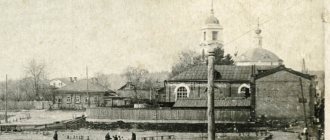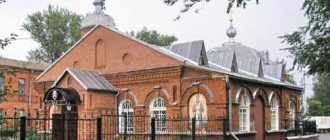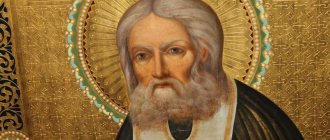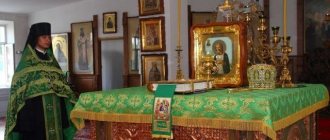Mir
Russia Tula region Tula Temple of St. Seraphim of Sarov (Tula) Map is loading...
{"format":"leaflet","minzoom":false,"maxzoom":false,"limit":50,"offset":0,"link":"all","sort":[""], "order":[],"headers":"show","mainlabel":"","intro":"","outro":"","searchlabel":"\u2026 \u0441\u043b\u0435\ u0434\u0443\u044e\u0449\u0438\u0435 \u0440\u0435\u0437\u0443\u043b\u044c\u0442\u0430\u0442\u044b","default":"","import-annotation":false,"width ":"auto","height":"350px","centre":{"text":"","title":"""link":"""lat":54.1872690000000005738911568187177181243896484375,"lon": 37.60685500000000303089109365828335285186767578125,"icon":""},"title":"","label":"","icon":"","lines":[],"polygons":[],"circles":[ ],"rectangles":[],"copycoords":false,"static":false,"zoom":8,"defzoom":14,"layers":["OpenStreetMap"],"image layers":[] ,"overlays":[],"resizable":false,"fullscreen":true,"scrollwheelzoom":true,"cluster":false,"clustermaxzoom":9,"clusterzoomonclick":true,"clustermaxradius":80, "clusterspiderfy":true,"geojson":"","clicktarget":"","showtitle":true,"hidenamespace":false,"template":"","userparam":"","activeicon": "","pagelabel":false,"ajaxcoordproperty":"","ajaxquery":"","locations":[{"text":"\u003Cb\u003E\u003Ca href=\"/palomnik/%D0% A5%D1%80%D0%B0%D0%BC_%D0%BF%D1%80%D0%B5%D0%BF%D0%BE%D0%B4%D0%BE%D0%B1%D0%BD% D0%BE%D0%B3%D0%BE_%D0%A1%D0%B5%D1%80%D0%B0%D1%84%D0%B8%D0%BC%D0%B0_%D0%A1%D0% B0%D1%80%D0%BE%D0%B2%D1%81%D0%BA%D0%BE%D0%B3%D0%BE_(%D0%A2%D1%83%D0%BB%D0%B0 )\» title=\»\u0425\u0440\u0430\u043c \u043f\u0440\u0435\u043f\u043e\u0434\u043e\u0431\u043d\u043e\u0433\u043e \u0421\u0435\u0440 \u0430\u0444\ u0438\u043c\u0430 \u0421\u0430\u0440\u043e\u0432\u0441\u043a\u043e\u0433\u043e (\u0422\u0443\u043b\u0430)\»\u003E\u0425\u0440 \u0430\u043c \u043f\ u0440\u0435\u043f\u043e\u0434\u043e\u0431\u043d\u043e\u0433\u043e\u0421\u0435\u0440\u0430\u0444\u0438\u043c\u0430\u0421\u0 430\u0440\u043e\u0432\u0441\ u043a\u043e\u0433\u043e (\u0422\u0443\u043b\u0430)\u003C/a\u003E\u003C/b\u003E\u003Chr /\u003E\u003Ca href=\"/palomnik/%D0%A1%D0% B2%D0%BE%D0%B9%D1%81%D1%82%D0%B2%D0%BE:%D0%90%D0%BD%D0%BD%D0%BE%D1%82%D0%B0 %D1%86%D0%B8%D1%8F\" title=\"\u0421\u0432\u043e\u0439\u0441\u0442\u0432\u043e:\u0410\u043d\u043d\u043e\u0442\u0430\u0446\ u0438\u044f\»\u003E\u0410\u043d\u043d\u043e\u0442\u0430\u0446\u0438\u044f\u003C/a\u003E: »'\u0425\u0440\u0430\u043c \u043f\u 0440\u0435\u043f \u043e\u0434\u043e\u0431\u043d\u043e\u0433\u043e \u0421\u0435\u0440\u0430\u0444\u0438\u043c\u0430 \u0421\u0430\u0440\u043e\ u0432\u0441\u043a\u043e\u0433 \u043e"' \u2013 \u043f\u0430\u043c\u044f\u0442\u043d\u0438\u043a \u0438\u0441\u0442\u043e\u0440\u0438\u0438 \u0438 \u043a\u 0443\u043b\u044c\u0442\u0443 \u0440\u044b \u0440\u0435\u0433\u0438\u043e\u043d\u0430\u043b\u044c\u043d\u043e\u0433\u043e \u0437\u043d\u0430\u0447\u0435\ u043d\u0438\u044f. XIX \u0432\u043 5\u043a\u0430\u043f\u0440\ u0438 \u0431\u043e\u0433\u0430\u0434\u0435\u043b\u044c\u043d\u0435, \u043e\u043d \u0434\u0435\u0439\u0441\u0442\u0432\u043e\ u0432\u0430\u043b\u043c\u0435 \u043d\u044c\u0448\u0435 \u0434\u0432\u0430\u0434\u0446\u0430\u0442\u0438 \u043b\u0435\u0442. \u041d\u043e\u0432\u044b\u0439 \u043e\u0442\u0441\u0447\u0435\u0442 \u0438\u0441\u0442\u043e\u0440\u0438\u0438 \u043d\u0430 \u0447\u0430\u043b\u0441\u044f \u0432 2002 \u0433\u043e\u0434\u0443.","title":"\u0425\u0440\u0430\u043c \u043f\u0440\u0435\u043f\u043e\u0434\u043e\u0431\u043d\ u043e\u0433\ u043e\u0421\u0435\u0440\u0430\u0444\u0438\u043c\u0430 \u0421\u0430\u0440\u043e\u0432\u0441\u043a\u043e\u0433\u043e (\u0422\u 0443\u043b\u0430)",» link":"""lat":54.1872690000000005738911568187177181243896484375,"lon":37.60685500000000303089109365828335285186767578125,"icon":""}]" imageLayers":[]}
54.187269; 37.606855
Russia, Tula, Friedrich Engels street, 32
Tula, Tula region
Russia
Telephone:
+7 (4872)565602
Email:
Temple of St. Seraphim of Sarov
– a historical and cultural monument of regional significance. Built at the beginning of the 19th century as an almshouse, it operated for less than twenty years. A new countdown of history began in 2002.
History[edit]
The Church of St. Seraphim of Sarov was built in Tula in 1905 as part of an almshouse for neglected poor people at the expense of Tula merchants, the Ermolaev-Zverev brothers - Alexander, Nikolai and Sergei. Consecrated by Bishop Lawrence of Tula and Belevsky on February 5, 1906.
In the shelter for street children and old people of all classes at the church in 1914, there were 130 people on charity. There was a priest and a psalm-reader on staff. The priest had an apartment at the orphanage.
A chapel in the name of St. was also assigned to the church. Theodosius of Chernigov, which is located at the new Trading Rows of Tula. Since 1906, an inventory of church property was kept in the temple, copies of metric books and confessional paintings were kept.
Here is what they wrote about the church at that time in the newspaper “Tula Diocesan Gazette”: “The cozy, clean, small church in its appearance is more like a chapel, but at the same time it perfectly matches the character, activity and simplicity of the saint. Seraphim of Sarov, who loved to pray in his small cell and hid all the destitute around him.
Wanting to provide both the church and the shelter for eternity, benefactors contributed substantial capital, the interest of which maintains this holy corner in Tula.”
The iconostasis of the temple in the name of Seraphim of Sarov was made of pine, in three tiers, with gilded carvings; the Royal Doors were also gilded. In the early 1920s, the Almshouse of St. Seraphim" (the name given to the charitable institution by the Soviet authorities) was closed. At the same time, the Church of Seraphim of Sarov was closed. Families of workers settled in shelter buildings. The dome of the church and the upper tiers of the bell tower were demolished, the buildings were empty, and later they housed warehouses for some time.
In the documents of the Foundation "Executive Committee of the Tula City Council of People's Deputies" there is a decision of the city executive committee dated July 20, 1976 on the transfer of the building of the former church to the archive department of the Tula Regional Executive Committee for an archival storage facility, which was rented by the regional society of the deaf and dumb for a club.
In 1991, the temple building was placed under state protection as a historical and cultural monument of regional significance.
When permission was given to create the parish (January 3, 2002), the temple premises were still used by the state archive. For a long time, the rector of the temple was forced to serve prayer services in front of the closed doors of the temple.
Then the archival documents were transported to another storage facility. On October 4, 2002, Bishop Kirill of Tula and Belev served the first liturgy in the church.
The temple building was in a dilapidated state - there were no crosses, the bell tower was destroyed. Restoration began, the interior of the temple was put in order: the ceiling and walls were plastered, a new floor was laid. The appearance of the temple was arranged: a dome and a cross over the altar, a dome and a cross over the refectory.
The parish, led by the rector, restored the bell tower destroyed during Soviet times; purchased the bells with funds from parishioners and benefactors from city organizations. Through the efforts of well-wishers, a finely carved oak iconostasis was erected, a water-blessing chapel was built in the courtyard of the temple and a monument to St. Seraphim of Sarov.
The temple was built at the end of the 19th century at an orphanage
It all started in 1891, when Archbishop Sergius turned to the Tula Duma with a request to give him one specific plot of land. Vladyka intended to create a whole complex of organizations there:
- parochial school;
- orphanage;
- vocational children's school;
- church.
Church of St. Sergius of Radonezh in an old photograph
The Archbishop did not ask for funding or assistance. He only needed land, and he was going to handle the rest with his own resources.
The Duma readily agreed and approved the priest’s idea, but he did not have time to complete what he started: he died.
Archbishop Sergius's successor in this matter was Archpriest Mikhail (Rozhdestvensky).
In 1891, the territory was fenced off and the necessary materials began to be collected. A year later, a couple of two-story buildings were erected on this land, and a year later, they were completely finished inside.
The plan of Archbishop Sergius was gradually realized, and corresponding institutions were opened in both buildings:
- northern building (lower floor) - parochial school;
- northern building (top floor) - living quarters for teachers;
- southern building (lower floor) - craft workshop;
- southern building (top floor) - living quarters for orphans.
1898 — 1899
during this time, the Church of St. Sergius of the Nativity and the bell tower were erected and opened
Around 1898, the Church of St. Sergius of the Rozhdestvensky and the bell tower were built here, and they were opened in 1989. Archpriest Mikhail became the first rector.
Children mastered turning and metalworking skills, and their work was sold. Three quarters of the proceeds helped maintain the entire complex, and the remaining quarter was set aside for the release of children.
Subsequently, a parish school for girls and a small hospital were opened there, where the poor were served free of charge.
Current state[edit]
In 2002, the parish of the church of St. Seraphim of Sarov, the city authorities adopted a resolution on the transfer of the temple to believers.
On October 4, 2002, the first liturgy after the transfer of the temple took place.
Currently in the church of St. Seraphim of Sarov services are held every day. The restoration of the external and internal appearance of the temple is gradually underway.
The city authorities gave the parish a small house where a baptismal church, a Sunday school, a library and a refectory are temporarily located.
There is no utility and administrative premises. In 2012, construction began on the church house, which will have spacious premises for all the needs of the parish.
Architecture and decoration of the building
Thanks to the assistance of the city authorities, lighting was installed around the complex and a fence was installed.
Funded by philanthropists, the following was built:
- chapel;
- belfry;
- baptismal
Appearance
The building was erected from red brick. Its architecture is made in pseudo-Byzantine style. It has a single-vaulted dome and a high bell tower. The base of the dome has oval windows. They are located around the entire perimeter of the drum.
Features of Byzantine temples:
- One-chapter composition.
- Step-shaped design of the main volume.
- Striped wall laying with three-part and two-part windows.
All this can be seen in this building.
Interior design
The prayer house of Seraphim of Sarov is unique because it is located in the basement. The walls are four meters high. This room has no paintings. But there is an altar installed here and services are held.
The main temple was painted by the artist Safronov. His painting was completely recreated in its original form. Upon completion of the restoration and opening of the temple, believers donated icons to the temple, including ancient and rare copies.
Shrines of the church
The church has many shrines.
In the chapel you can bow before the icons:
- Half-length image of Seraphim of Sarov.
- The monk in full height with a piece of rags.
- Diveyevo Reverend Wives - Elena, Martha and Alexandra.
- The famous nuns of the Diveyevo Monastery - Maria, Pelageya and Paraskeva.
There are also pieces of relics in the temple. They are asked for help in business and in getting rid of illness.
The church contains the relics of saints:
- Seraphim of Sarov;
- Diveevsky's wives - Elena, Martha and Alexandra.
Activities of the parish[edit]
The church has a small library of spiritual books and a Sunday school for children. A weekly course on the basics of church singing and reading in Church Slavonic, a singing school and an art school are organized for parishioners.
The clergy of the temple cares for patients in the Tula drug treatment center and people in Tula pre-trial detention center No. 1, as well as people on probation.
The rector of the church serves liturgy and festive water-blessing prayers for the twelfth and great Orthodox holidays in places of deprivation of liberty: he confesses, gives communion to prisoners, conducts spiritual conversations with the distribution of spiritual literature, icons, crosses, candles and holy water, talks with the officers of the pre-trial detention center.
Twice a month the priest of the temple visits patients of the Tula Regional Narcological Dispensary. Parishioners of the temple work with children in the social rehabilitation center for minors No. 3 in Tula.
Sunday School
When the chapel began operating, 3 Sunday schools were opened. Since 1992, only one school has been operating. The main Orthodox sciences are taught here. Various clubs and creative evenings were organized for children. Now they organize holiday meetings and concerts for their parents.
The school educates children from 6 to 15 years old.
The following subjects are taught in Sunday school:
- Orthodox Catechism.
- Liturgics.
- Church Slavonic language.
- History of the Russian Church.
Between lessons, children are treated to tea. School hours are from 11:00 to 14:00.
From April 30, 2021, classes for adults are offered on Sundays.
They study the following subjects:
- Fundamentals of Orthodox culture.
- Slavic church language.
Details can be found by calling 47-42-22.
Pilgrim[edit]
The rector of the temple is Archpriest Sergiy Mosyagin.
Divine Liturgy at 8-00, evening service at 17-00.
Every Sunday at 17-00 an akathist is read to St. Seraphim of Sarov with the distribution of blessed crackers.
Every Monday at 5:00 p.m. an akathist to St. Spyridon of Trimythous is read, every Thursday at 5:00 p.m. an akathist to St. Nicholas, every Friday an akathist to the Mother of God “Tenderness.”
On the last Friday of the month at 5 p.m., a water-blessing prayer service is served with an akathist to the “Inexhaustible Chalice” icon of the Mother of God.
There is a small children's playground in the courtyard of the temple.
In the 30s, the Church of Sergius of Radonezh was closed
In the 10s of the 20th century, a dark streak began in the life of the temple. In 1915, Archpriest Mikhail died, and a revolution was just around the corner, which brought a lot of trouble to the believers of our country.
In 1929, authorities ordered the temple to be closed. According to the papers, it turned out that this order was for the good - the premises were being confiscated for cultural needs. But the Orthodox did not like this prospect.
L.M. writes about these events in the book “How Russian Temples Perished.” Zakharova:
“The state archive preserves the petition of the residents of Zarechye to the city council to leave the St. Sergius Church to the believers.
Several sheets of paper were signed by 1,304 residents of Tula, indicating their age and home address. These are mainly residents of Oktyabrskaya Street.
In another petition, 184 residents of Kurulovka asked not to dismantle the bell tower of the Sergius Church, since the ringing of the bells replaced their clocks.”
But no one wanted to listen to the people’s opinion, and in 1930 the temple was closed. But for what purpose, they couldn’t decide for a long time.
The authorities destroyed the bell tower, against the will of local residents.
There they organized either a tobacco warehouse, a transit prison, a utility room for the military, etc.
But the Bolsheviks decided not to preserve the bell tower and mercilessly destroyed it.
Perhaps demolishing the church would be too expensive. At least, it was this reason that prevented it from being destroyed later - in 1980, when they were preparing for the Olympics.
Restored Church of St. Sergius of Radonezh
The authorities figured out what would be cheaper for them: to improve the building or completely dismantle it. The first option turned out to be more economical. He was given preference.
So the Church of Sergei of Radonezh survived until the saving 90s, when the entire Orthodox (and not only) world calmly exhaled and felt safe.
Donskoy Monastery
Church on the territory of the Donskoy Monastery
became the first in Moscow dedicated to Seraphim of Sarov. The decision to build a church was made by Nicholas II at the beginning of the 20th century. The architect of the project was Ivan Sergeevich Kuznetsov. Construction lasted from 1903 to 1914.
The church had two levels
:
- Upper;
- Underground.
The upper temple was originally dedicated to Saint Seraphim. It included an altar, a refectory and a bell tower. During construction, it was decided to dedicate the underground building, which houses burial vaults, to Anna Kashinskaya.
In 1918, when the monastery's lands were confiscated, the church was turned into an anti-religious museum. In the mid-1920s, they decided to convert it into a crematorium; the refurbishment project was entrusted to Dmitry Osipov. The temple has undergone many changes - the bell tower was demolished, and its place was taken by a concrete parallelepiped; the western wall and the entrance to the building were rebuilt; partitions and crypts in the lower temple were dismantled; nothing remained of the interior decoration. So, in 1927 the crematorium was opened.
The church was returned to the revived Donskoy Monastery only in 1992, but the monastery did not have enough funds for reconstruction at that time. The first work on its restoration began in the late 1990s, and regular services began to take place only in the early 2000s.
Currently, the church hosts daily services, weddings, and baptisms. A restoration project has been prepared, after which the temple will appear in its former beauty.
Cremation Distribution Society
The equipment delivered to the USSR for the “most progressive type of burial” was German; its installation was completed in 1926, and several “trial runs” took place in 1927.
The grand opening of the crematorium took place on the eve of the tenth anniversary of the October Revolution. (At first they wanted to officially open it on November 7, 1927, but they realized it in time, deciding that public opinion might misinterpret such an event). However, Muscovites were stubbornly in no hurry to use the “progressive method of burial.”
Photo from the 1930s. In the foreground is the current fraternal territory of the Donskoy Monastery. Behind the horizontal wall is the new territory of the Donskoy Monastery, converted into a cemetery with a crematorium.
Then the press began actively promoting a new method of burial. Its initiators were the “Union of Militant Atheists” and the specially formed “Society for the Propagation of the Idea of Cremation.”
Articles and feuilletons on this unique topic appeared so often that mentions of it even found their way into “The Golden Calf” by Ilf and Petrov and “The Master and Margarita” by M.A. Bulgakov.
And yet, the Moscow crematorium began operating at full capacity only in the 1930s, with the beginning of repression. During the war, the corpses of those who died in hospitals were burned here, out of fear of an epidemic.
As a result, in the modern New Donskoy Cemetery you can study the history of Russia of the 20th century - the memorial to those killed in the Great Patriotic War is adjacent to the mass graves of victims of repression, on which individual plaques have already been installed by relatives in our days.
The crematorium at the New Donskoy Cemetery continued to operate until 1972, then protests began from Muscovites, pointing out that residential development had come close to the former monastery territory. Individual burnings were held here until 1982, and then farewell ceremonies took place for several more years.
Memorial to those killed in the Great Patriotic War at the New Donskoy Cemetery. (On the walls are the names of the soldiers buried here; the lists are still being updated and updated).
In 1992, the mutilated temple was returned to the revived Donskoy stauropegial monastery.
Turn the temple into... a crematorium
In 1918, the lands of the Donskoy Monastery were confiscated. And while monastic life on the old territory continued until the mid-1920s and an anti-religious museum functioned for some time, thanks to which it was possible to generally preserve the architectural ensemble, the new government was in full control of the former monastery cemetery.
In the mid-1920s, it was decided to convert the Seraphim Church into a crematorium. Several projects took part in the announced competition, but the reconstruction option proposed by Dmitry Petrovich Osipov was recognized as the best.
According to this plan, the main volume of the temple building remained unchanged. The bell tower was to be demolished, and a concrete parallelepiped was erected instead; The western wall with the entrance underwent the most extensive restructuring.
The partitions and crypts in the lower temple were also dismantled. (All the burials existing by that time were moved from there to the necropolis of the Donskoy Monastery on the old territory). A furnace was installed in the eastern part of the lower temple, and the entire upper one was converted into a ritual hall and columbarium.








